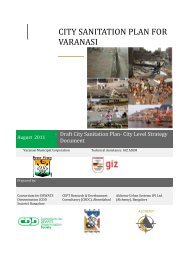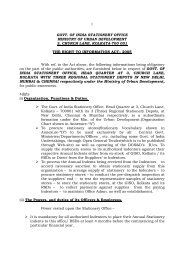CITY SANITATION PLAN - Ministry of Urban Development
CITY SANITATION PLAN - Ministry of Urban Development
CITY SANITATION PLAN - Ministry of Urban Development
Create successful ePaper yourself
Turn your PDF publications into a flip-book with our unique Google optimized e-Paper software.
<strong>CITY</strong> <strong>SANITATION</strong> <strong>PLAN</strong> BAREILLY<br />
Adequacy: The water seal is effective at preventing odors and it is appropriate for those who sit or<br />
squat (pedestal or slab) as well as those who cleanse with water. It is only appropriate when there is<br />
a constant supply <strong>of</strong> water available. The Pour Flush Toilet requires much less water than a<br />
traditional cistern Flush Toilet. However, because a smaller amount <strong>of</strong> water is used, the Pour Flush<br />
Toilet may clog more easily and thus, require more maintenance. If water is available, this type <strong>of</strong><br />
toilet is appropriate for both public and private applications. Pour Flush Toilets are adequate for<br />
almost all climates.<br />
Health Aspects/Acceptance: The Pour Flush Toilet (or squatting pan) prevents users from seeing or<br />
smelling the excreta <strong>of</strong> previous users. Thus, it is generally well accepted. Provided that the water<br />
seal is working well, there should be no odors and the toilet should be clean and comfortable to use.<br />
Maintenance: Because there are no mechanical parts, Pour Flush Toilets are quite robust and rarely<br />
require repair. Despite the fact that water is used continuously in the toilet, it should be cleaned<br />
regularly to prevent the buildup <strong>of</strong> organics and or/stains. To prevent clogging <strong>of</strong> the Pour Flush<br />
Toilet, it is recommended that dry cleansing materials be collected separately and not flushed down<br />
the toilet.<br />
Pros & Cons<br />
The water seal effectively prevents odors<br />
The excreta <strong>of</strong> one user are flushed away before the next user arrives<br />
Suitable for all types <strong>of</strong> users (sitters, squatters, wipers and washers)<br />
Low capital costs; operating costs depend on the price <strong>of</strong> water requires a constant source <strong>of</strong><br />
water (can be recycled water and/or collected rain water)<br />
Requires some education to be used correctly<br />
Reference: Mara, DD (1996), Low-Cost <strong>Urban</strong> Sanitation. Wiley, Chichester, UK.<br />
(Provides detailed drawings <strong>of</strong> Indian glass-fibre squat pan and trap with dimensions and critical<br />
design criteria. A description <strong>of</strong> how to modify a Pour Flush Toilet to a cistern Flush Toilet is<br />
included)<br />
Single Ventilated Improved Pit (VIP)<br />
Application Level- Household,<br />
ADMINISTRATIVE STAFF COLLEGE OF INDIA, HYDERABAD Page 150
















